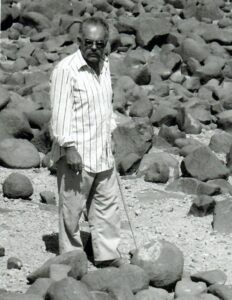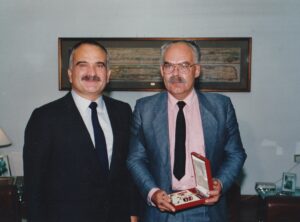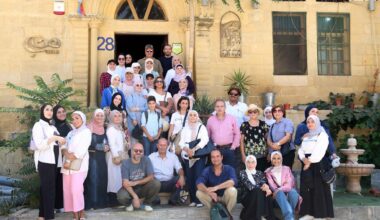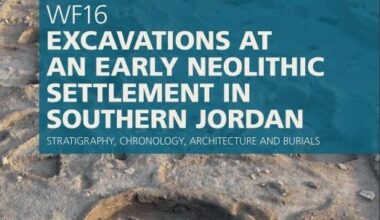It is with deep sadness that CBRL has learned of the death of the British anthropologist, William Lancaster, on 19 May 2022, former Director of the British Institute at Amman for Archaeology and History (BIAAH) from 1991 to 1994, the forerunner of the Council for British Research in the Levant’s Amman Institute founded in the 1970s.

Working in partnership with his wife, Fidelity, William possessed an unparalleled knowledge of nomadic tribal society across the Arab world—from Syria, Jordan, northern Saudi Arabia, and Oman, to the United Arab Emirates. His first book (1981) was based upon many years spent living with the Rwala Bedouin in the 1970s, where the tribe accepted him and his family as one of their own. His second book, co-authored with Fidelity (1999), provides an overview of 25 years of their research together, where “[h]aving become aware of the depth in time of Arab tribal structures, the authors have developed a view of Arabic tribal discourse where ‘tribe’ is seen as essentially an identity that confers access to a social structure and its processes”. A deep knowledge, respect and appreciation for “indigenous theories of land use and resource management” forms the basis of their books and numerous articles, papers and reports, where they consider both social constructs and material remains.
William had early contact with the British School of Archaeology in Jerusalem (BSAJ), CBRL’s founding institute, when his father, Osbert Lancaster (the renowned cartoonist and architectural historian), met Kathleen Kenyon at an Oxford celebratory formal dinner (gaudy) and mentioned that his son was interested in the Middle East. William was consequently invited to participate in BSAJ excavations, particularly those directed by Peter Parr in Petra where William together with Mick Wright were the dig photographers. The team lived in caves, like the local Bedouin, the Bdūl, in those days with whom he had many contacts. It appears that this experience confirmed his interest to be “in the study of living people rather than the dead”.
William then went to learn Arabic at the Middle East Centre for Arabic Studies (MECAS) in Shemlan, Lebanon where he met both Kim Philby and George Blake, something which amused members of the Rwala tribe he later lived with, who teased him mercilessly about being a spy! After reading archaeology and anthropology at Magdalene College, Cambridge, his first anthropological study with his wife Fidelity was of Hennage, the village in Norfolk in which they lived, after which they started their work together in the Arab World in 1971.

William and Fidelity were integral to providing anthropological context, conducting ethnoarchaeology, for groundbreaking archaeological projects of the British Institute at Amman for Archaeology and History (BIAAH) in the 1980s and early 1990s. He also spent a year teaching anthropology at Yarmouk University in the mid-1980s. William and Fidelity featured in several significant BIAAH projects, including the Burqu’/Ruweishid (1988-91) and Dhuweila (1986) projects led by Alison Betts; the 1988 Wadi Jilat excavations led by then BIAAH director, Andrew Garrard; and the Khirbet Faris project (1988-1994) on the Karak Plateau led by Alison McQuitty, another former BIAAH director and first CBRL director, and Jeremy Johns.
This project involvement led to William’s appointment as BIAAH director. His directorship began shortly after the first Gulf War, with William advising and supporting colleagues and projects through this uncertain period. He also undertook the task of moving the Institute from a villa near the main gate of the University of Jordan to its second home in the Jubaiha neighbourhood, north of the university. He also collaborated in the organisation of the 5th International Conference on the Archaeology and History of Jordan in 1992 with fellow international institute directors in Amman.
William and Fidelity continued their anthropological fieldwork as part of BIAAH archaeological projects throughout his directorship. Importantly, they undertook major anthropological fieldwork in the Wadis Dana and Faynan commissioned by the Royal Society for the Conservation of Nature (RSCN), funded by the World Bank, when the Dana Reserve was being established. This experience and the connections made were instrumental in William’s inspiration for what would become BIAAH’s/CBRL’s Wadi Faynan Project in the lower part of Dana Nature Reserve (McQuitty 1998).
William and Fidelity conducted studies throughout Arabia, including the Wahiba Sands for the Royal Geographical Society and the Joint British, French and Italian Ra’s al-Hadd projects in Oman, and they were invited by the Emirate of Ras al-Khaimah to compile an archive of ‘life before oil’ for the National Museum. From their home on the island of Hoy in the Orkneys, they continued academic research and publishing while managing their own sheep farm.
William was elected a Fellow of the Royal Asiatic Society in 1993 and served as co-editor of Nomadic Peoples, the journal of the Commission on Nomadic Peoples. In recognition of his many years of anthropological work in the country, he was presented with Jordan’s Order of Independence medal (second class) in 1992 by then Crown Prince Hassan bin Talal for his ‘services to Jordan’.

A private memorial is planned. William is survived by his wife, Fidelity, and sons and daughters: Osbert, Nathaniel, Laura and Hetty.
30 March 2022; Updated 2 June 2022
Selected references:
Betts, A.V.G., Cropper, D., Martin, L. and C. McCartney. 2013. The Later Prehistory of the Badia. Levant Supplementary Series 11. Oxford: CBRL and Oxbow Books.
Lancaster, W. 1981. The Rwala Bedouin Today. Cambridge: Cambridge University Press.
Lancaster, W. and F. Lancaster. 1999. People, Land and Water in the Arab Middle East: environments and landscapes in the Bilâd ash-Shâm. Reading: Harwood Academic Publishers.
Lancaster, W. and F. Lancaster. 2006. Integration into modernity: some tribal rural societies in the Bilâd ash-Shâm. In D. Chatty (ed.) Nomadic Societies in the Middle East and North Africa, pp. 335-369. Leiden: Brill.
McQuitty, A. 1998. The Wadi Faynan project: a preface. Levant 30: 1-3.















